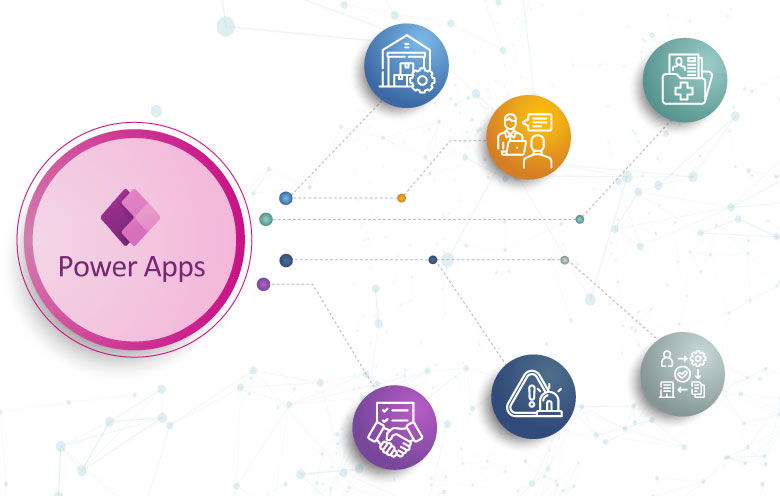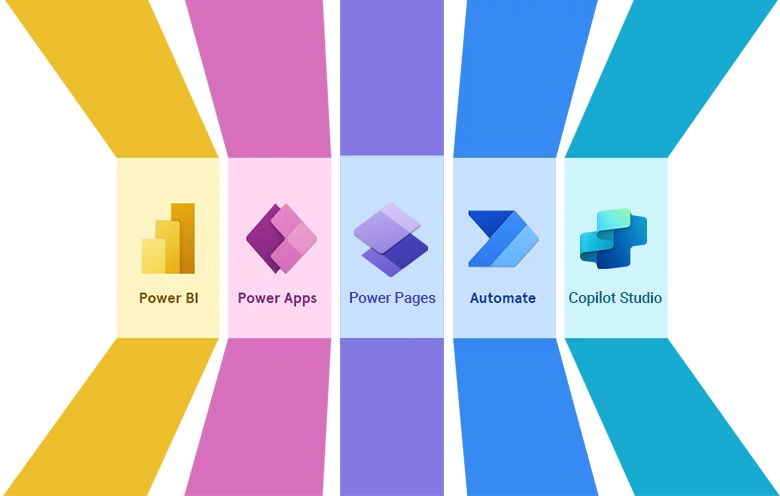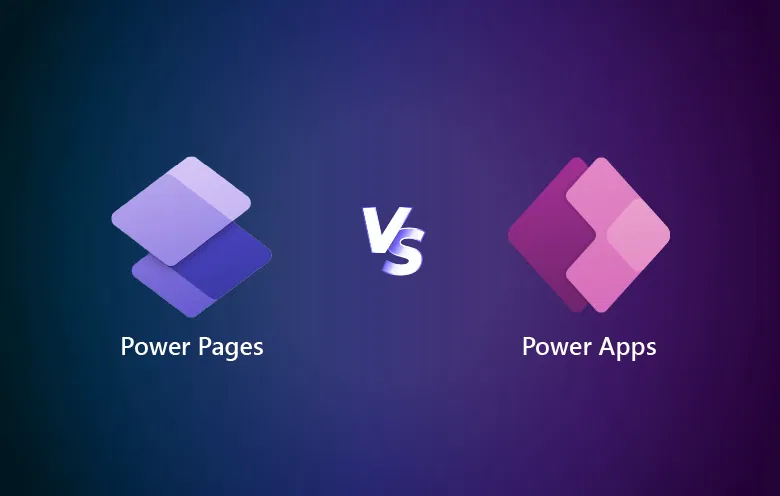Businesses are constantly seeking innovative solutions to streamline processes, enhance productivity, and improve customer experiences in today’s digital era. Microsoft Power Apps has emerged as a powerful platform that empowers organizations to create custom applications without extensive coding knowledge, and Power Apps consulting services help them make the most of this capability.
Microsoft Power Apps has become a game-changer, enabling businesses to rapidly adapt to evolving market demands and stay ahead of the competition. With its intuitive interface and robust functionality, Power Apps allows organizations to innovate at scale, drive digital transformation, and unlock new opportunities for growth.
Businesses can transform manual processes into automated workflows, drive collaboration among teams, and deliver tailored solutions to meet specific business needs. In this blog, we’ll explore top 9 Microsoft Power Apps use cases in 2026, showcasing its versatility and impact across various industries. Through real-world examples and insights, this blog will demonstrate how Power Apps is revolutionizing business operations and driving tangible results in the dynamic landscape of 2026.
The Total Economic Impact of Power Apps study by Forrester revealed that the companies that used Power Apps to develop their custom applications reduced their app development costs by 74%.
Let’s look at some Power Apps business use cases for various industries:
1. Instant quote generation
Creating accurate and timely quotes for products or services can be a complex task, especially when dealing with multiple variables such as pricing tiers, discounts, and customizations. Traditional methods often involve manual calculations, leading to errors, delays, and inconsistencies in the quoting process. Additionally, managing and updating quote templates across teams can be cumbersome and prone to version control issues.
How Power Apps can help:
Microsoft Power Apps enables businesses with customized quote generation applications tailored to their specific needs. With its intuitive drag-and-drop interface and integration capabilities with data sources like Excel or databases, Power Apps simplifies the creation of dynamic quote forms. Automated calculations, logic-based workflows, and real-time data updates ensure accuracy and efficiency in generating quotes.
Real-world example: Regal Beloit
The sales teams at Regal Beloit utilize a mobile Power Apps solution to simplify the documentation of cost savings and the submission of proposals for approval.
Benefits:
- Efficiency
- Accuracy
- Modification of quote template
- Integration with CRM systems
- Time-savings
2. Inventory management app
Managing inventory efficiently is a critical aspect of business operations, presenting various challenges such as inventory inaccuracies, stockouts, overstocking, and manual data entry errors. Traditional methods of inventory management often involve tedious manual processes, spreadsheets prone to errors, and lack of real-time visibility into stock levels and movements.
How Power Apps can help:
Companies can build customized inventory management applications that address these challenges effectively with Microsoft Power Apps. With its user-friendly interface and integration capabilities with databases and IoT devices, Power Apps streamlines inventory tracking, updates, and analysis. Automated workflows, barcode scanning, and real-time data synchronization enhance accuracy and efficiency in inventory management.
Real-world example: Electrolock
Electrolock, a leading provider of insulation products and solutions for the manufacturing industry, collaborated with a service provider to create an inventory management solution using Power Apps, Power Automate, and Microsoft Dataverse.
Benefits:
- Enhanced visibility
- Automation of manual inventory management
- Scalability
- Integration with ERP systems
- Compliance
3. Interview process application
Managing the interview process efficiently involves coordinating schedules, collecting candidate information, conducting assessments, and communicating feedback across multiple stakeholders. Manual processes and disparate tools can lead to scheduling conflicts, data duplication, communication gaps, and delays in hiring decisions.
How Power Apps can help:
Organizations can build a customized interview process application that streamlines the entire hiring process with Power Apps. With its intuitive interface and integration capabilities with Office 365 tools like Outlook and SharePoint, Power Apps simplifies scheduling, candidate tracking, evaluation, and feedback collection. Automated workflows and notifications ensure timely actions and seamless collaboration among hiring teams.
Real-world example: Microsoft
Microsoft’s HR team evaluated various platforms, including Power Apps, for user experience. The team found PowerApps to provide the necessary level of UI richness. They invested in Power Apps, refining solutions with Microsoft IT and Power Apps team. This led to a suite of Thrive apps deployed to over 100k employees, driven by their customer-centric team.
Benefits:
- Efficient hiring
- Better employee engagement
- Enhanced collaboration
- Data-driven decisions
4. Patient management app
Managing patient information, appointments, medical records, and treatment plans can be complex and time-consuming for healthcare providers. Challenges include manual data entry, paper-based processes, disparate systems for patient records, and limited access to real-time patient information. Ensuring data accuracy, privacy compliance, and efficient communication among healthcare teams are also critical challenges in patient management.
How Power Apps can help:
Healthcare providers can build a customized patient management application that addresses these challenges effectively with Power Apps. With its intuitive interface and integration capabilities with Electronic Health Record (EHR) systems, scheduling software, and communication tools, Power Apps streamlines patient data management, appointment scheduling, treatment tracking, and communication. Automated workflows, data encryption, and role-based access control enhance data security and privacy compliance.
Real-world example: Leonard Cheshire
Caregivers utilize canvas apps and model-driven apps, in conjunction with Dynamics 365, to manage healthcare services for individuals with disabilities at Leonard Cheshire.
Benefits:
- Centralized patient data
- Automate patient appointment scheduling
- Secure communication
- Patient engagement
- Adherence to compliance
5. Employee onboarding app
Employee onboarding involves multiple tasks such as paperwork completion, training sessions, IT setup, and orientation activities. Challenges in traditional onboarding processes include manual paperwork, disjointed communication, lack of standardization, and delays in accessing essential resources. Ensuring a seamless and efficient onboarding experience for new employees while maintaining compliance with company policies and regulations is essential.
How Power Apps can help:
Recruiters can build a customized employee onboarding application that addresses these challenges effectively. With its user-friendly interface and integration capabilities with HRIS systems, document management platforms, and communication tools, Power Apps simplifies onboarding workflows, automates task assignments, facilitates communication, and provides self-service options for new hires. Automated notifications, checklists, and personalized dashboards enhance transparency and efficiency in the onboarding process.
Real-world example: Sonae
Sonae MC, a prominent company within the Sonae portfolio, is a leading figure in Portugal’s food retail industry. Their Workplace Design team utilized Power Automate that includes Power Apps to create a solution aimed at improving their Sonae Contacto Traineeship Programme. This initiative aims to attract, retain, and onboard selected candidates more effectively.
Benefits:
- Streamlined onboarding processes
- Efficient task management
- Compliance and data security
- Enhanced employee experience
- Analytics and reporting
6. Service request app
Managing service requests efficiently is essential for organizations to ensure timely resolution of issues, maintain customer satisfaction, and optimize resource allocation. Challenges in traditional service request management include manual request intake, routing inefficiencies, lack of visibility into request status, and delays in response and resolution times. Additionally, coordinating with service teams, tracking service history, and prioritizing requests based on urgency are critical challenges.
How Power Apps can help:
Businesses can build a customized service request application that addresses these challenges effectively. With its intuitive interface and integration capabilities with CRM systems, ticketing platforms, and communication tools, Power Apps streamlines service request intake, assignment, tracking, and resolution. Automated workflows, notifications, and real-time updates enhance visibility, communication, and efficiency in service request management.
Real-world example: Autoglass (part of Belron group)
Martin Lee, also known as the “App Man,” developed more than 40 Power Apps solutions tailored for field technicians, leadership conferences, and various other purposes. These applications seamlessly integrate with Microsoft Dataverse and SharePoint.
Benefits:
- Streamlined request intake
- Automated task assignment
- Real-time updates
- Improved customer satisfaction
- Efficiency and cost savings
7. Crisis management app
Crisis management involves coordinating response efforts, communication, and resource allocation during emergency situations such as natural disasters, security incidents, or public health crises. Challenges in traditional crisis management processes include fragmented communication channels, delayed response times, lack of real-time situational awareness, and difficulty in coordinating actions among stakeholders.
Ensuring swift and effective response, maintaining public safety, and minimizing impact on operations are critical challenges in crisis management.
How Power Apps can help:
Firms can build a customized crisis management application that addresses these challenges effectively. With its intuitive interface and integration capabilities with communication tools, mapping software, emergency alert systems, and data sources, Power Apps streamlines crisis response, communication, resource mobilization, and decision-making.
Automated workflows, real-time updates, geolocation tracking, and role-based access control enhance situational awareness and coordination during crises.
Real-world example: City of Kobe
Several solutions were created in response to the COVID crisis, offering updates on special cash payments and delivering information through chatbots and dashboards. These solutions utilize the entire Power Platform, including Power Pages, Power Apps, Power Automate, Power Virtual Agents, and Power BI.
Benefits:
- Real-time situational awareness
- Incident tracking and reporting
- Resource mobilization
- Collaboration and coordination
- Public safety
8. Project management app
Managing projects involves coordinating tasks, resources, timelines, and stakeholders to ensure successful project delivery. Challenges in traditional project management processes include manual task tracking, communication silos, version control issues, lack of real-time project visibility, and difficulty in monitoring project progress. Ensuring project alignment with objectives, meeting deadlines, and optimizing resource utilization are critical challenges in project management.
How Power Apps can help:
Companies can build a customized project management application that addresses these challenges effectively. With its intuitive interface and integration capabilities with project management tools, collaboration platforms, and data sources, Power Apps streamlines project planning, task tracking, communication, and reporting. Automated workflows, real-time updates, customizable dashboards, and role-based access control enhance project visibility, collaboration, and decision-making.
Real-world example: Total Solar (France)
Total Solar leveraged Power Apps, Power Automate, and Power BI, in conjunction with Microsoft Teams, to replace spreadsheets and centralize project management for global projects.
Benefits:
- Centralized project management
- Automated task tracking
- Real-time collaboration
- Customizable dashboards
- Resource optimization
9. Site inspection app
Conducting site inspections involves capturing detailed information, assessing conditions, identifying hazards, and documenting findings for regulatory compliance and safety purposes. Challenges in traditional site inspection processes include manual data entry, paper-based forms, lack of real-time data access, and difficulty in standardizing inspection procedures. Ensuring accuracy, consistency, and timely reporting of inspection results are critical challenges in site inspection management.
How Power Apps can help:
Businesses can build a customized site inspection application that addresses these challenges effectively. With its intuitive interface and integration capabilities with GIS mapping tools, data sources, and reporting platforms, Power Apps streamlines site inspection workflows, data collection, analysis, and reporting. Mobile accessibility, offline data capture, image annotations, and automated workflows enhance inspection efficiency and accuracy.
Real-world example: Leonardo Global Solutions
They utilize a Power Apps solution to oversee a multi-stage inspection process, ensuring compliance with facility management guidelines for areas like canteens, cleaning, green spaces, and other facilities.
Benefits:
- Streamlined inspection processes
- Customizable templates
- Data analysis and reporting
- Image and data capture
- Automated workflows
10. Automated claims and broking processing app
Processing insurance claims and broking communications includes manual sorting and prioritizing of thousands of emails, case assignment to team members, and coordination with clients and carriers. It also requires adherence to data protection regulations. Traditional claims processing imposes challenges like:
- Scattered shared mailboxes with limited access permissions
- Manual case assignments prone to human error
- Lack of centralized visibility
- Difficulty in tracking metrics around case resolution
Ensuring end-to-end automation while maintaining regulatory compliance are critical challenges in claims management.
How Power Apps can help:
Power Apps can help organizations such as insurance brokers, healthcare networks, large corporates, build a unified case-processing application that addresses claim management challenges effectively. It can streamline case capture, assignment, and resolution processes. And provides real-time case tracking, automated status updates, document management, and comprehensive dashboard visibility.
Real-world example: Aon Brazil CRS
They utilize a Power Apps solution (SLS app) to manage complex insurance claims and broking workflows, automatically capturing incoming cases, assigning them to appropriate team members, and tracking resolution metrics in real-time.
Benefits:
- Improved compliance and data governance
- Enhanced team productivity and efficiency
- Better capacity planning and cost management
- Comprehensive case load visibility per team member
- Reduction in deployment time
11. Digital insurance quoting and automation app
Digital insurance operations management includes processing customer applications, creating quotes from multiple carriers, requesting missing information, and coordinating across thousands of customers through multiple channels. It includes challenges such as:
- Manual follow-ups with customers
- Time-consuming validation of data from non-API carriers
- Labour-intensive review of documents
- Inability to scale the operations without compromising on the quality of service
Keeping up the rapid growth while keeping operational costs under control remain major challenges in managing digital insurance.
How Power Apps can help:
Power Apps can help insurance companies build comprehensive automation solutions that address these scalability challenges. It enables automated customer communications, intelligent document processing, data extraction from unstructured content, and seamless carrier data integration. Customized email and text flows, sentiment analysis, and AI-driven quote generation enhance operational efficiency and customer satisfaction.
Real-world example: Nsure.com
They implemented Power Platform solutions combining PowerApps with AI-driven automation to process over 100,000 monthly customer interactions, validate and standardize data from 50+ insurance carriers, and automate quote generation, reducing manual processing requirements by over 60%.
Benefits:
- Automated appointment rescheduling based on email
- Cost reduction in operations
- Increase in revenue CAGR
- Ability to sell many times more policies per agent
- Enhanced customer satisfaction
12. AI-powered helpdesk chatbot app
Helpdesk support management requires responding to thousands of requests of employees for troubleshooting of technical problems, restoring system access, or explaining some aspects of IT resources and procedures. Helpdesk has common challenges such as agents overwhelmed with repetitive routine requests, longer waiting times for workers, lost productivity due to addressing routine inquiries, and inability to scale support during peak periods. Providing service at an appropriate level with the effective use of resources is a crucial challenge in helpdesk management.
How Power Apps can help:
By combining Copilot Studio for chatbot design with Power Apps for integration and automation, organizations can deliver intelligent apps that enable automated query resolution, targeted question-answer flows, and seamless redirection to specific resources. Together, they provide guided interactions, device specific support, and complete process automation for greater efficiency.
Real-world example: Pacific Gas and Electric Company
They developed “Peggy,” an AI-powered chatbot built with Microsoft Copilot Studio, to handle employee helpdesk requests including Citrix login assistance, SAP account unlocking (4,200+ calls annually), and general IT inquiries, significantly reducing agent workload and improving response times.
Benefits:
- Cost savings on helpdesk operations
- Agents freed to focus on complex issues requiring human intervention
- Trigger phrase recognition for intelligent query routing
- Reduced wait times for employees seeking technical support
- Improved overall service level metrics through optimized agent allocation
Suggested: 15 use cases of Power Automate to leverage in 2026 and beyond
Empowering business success: The impact of Microsoft Power Apps in 2026
The adoption of Microsoft Power Apps in 2026 would signify a strategic shift towards digital innovation and operational excellence. As organizations continue to utilize the capabilities of Power Apps, they will streamline operations, drive cost efficiencies, and cultivate a culture of continuous improvement and agility. With Power Apps at the forefront of digital transformation initiatives, businesses will be well-positioned to thrive in a rapidly evolving business landscape. To know more about how Power Apps can drive bottom-line results and foster competitive advantages for your business, talk to our experts!



